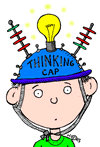These notes
are in two parts.
1. Under the heading WHAT WE WILL
TALK ABOUT we have provided a guide to what we think we need
to talk about in this passage.
2. Under the heading WHAT WE
MIGHT SAY we have provided an imaginary high order book
orientation to show how what we need to talk about becomes
actual lessons.
You might like
to read each of the two parts side by side.
Giving the lessons
Note that we don't
say everything that we might in the first High Order Book
Orientation. In scaffolding, one does not overwhelm with the
amount of information. Later conversations allow us to address
more.
The Questioning style of:
|
Preformulation
Question
Response
Reconceptualisation
|
is used throughout.

- We read the section of text
we are talking about before we prepare for the question.
- We use the Preformulation to
give only the amount of information necessary to ensure
children can read the text.
- We use the Reconceptualisation
to add one extra bit of information.
- When we return the next time,
children will volunteer and talk about what we told them
on the previous day. We then use Reconceptualisation to
add another piece of information.
- Some of the information listed
in What We Might Say might not be talked about until the
Transformation.
- In this part of the sequence
we expect the students to answer in the words of the text.
We continue to ask more than one volunteer to answer.
Next
Page:- What We Will Talk About